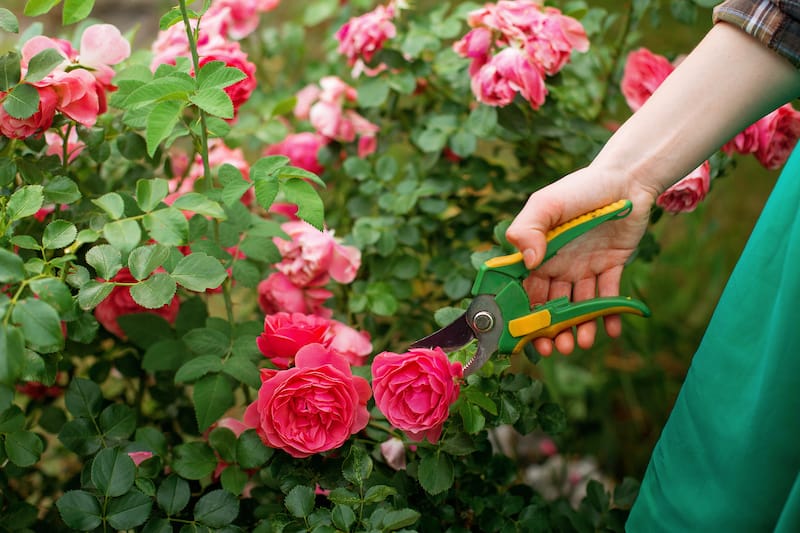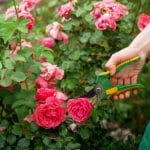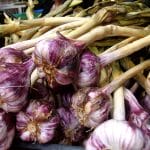A Guide To Planting and Pruning Roses
How To's In The Garden Pruning

Why Roses Are Easier Than You Think
Roses might look fancy, but they’re tougher than most people think. Gardeners have been cultivating them for hundreds of years in various locations, from fabulous English gardens to hot California gardens. They don’t need special care — just the basics: lots of sun, healthy soil, regular watering, and a trim once a year. You can think of roses like a fruit tree’s pretty cousin. Give them a good start and a little attention, and they’ll cover you in flowers season after season.
Best Tips for Planting Roses and Getting Healthy Blooms
Roses don’t like being crammed into poor soil or stuck in too much shade. If you can give them 6–8 hours of sun and decent drainage, you’re most of the way there.
- When to plant: Bare-root roses are happiest when planted in late winter or early spring while they’re still dormant. Potted ones can go in almost any time the soil isn’t frozen, though spring and fall give them the easiest start.
- Soil prep: They’re hungry feeders. I mix in compost or worm castings whenever I plant, and if you’ve got clay soil, break it up with some sand or bark chips so the roots don’t drown.
- Depth matters: The graft union — that little knobby bump near the base — should sit just above soil level in warm zones, but I bury it a couple of inches in colder spots to shield it from winter.
- Mulch blanket: Two or three inches of mulch keeps roots cool, saves water, and stops weeds from stealing the show.
It’s not rocket science. Roses like to be planted deep enough to anchor, rich enough to feed, and loose enough to breathe.
Watering and Feeding Roses Without Babysitting Them
Here’s the thing about watering roses: they don’t want constant sips. They want a good, deep drink that reaches their toes.
- Water schedule: A solid soaking once or twice a week is more effective than a daily sprinkle. Always water at the base — wet leaves invite black spot and mildew.
- Feeding: Roses are like teenagers; they’ll eat constantly if you let them. I give mine compost tea or an organic rose fertilizer once a month during the growing season. Then I back off about six weeks before frost to let them harden up for winter.
I’ve burned roses before by getting too eager with the fertilizer. These days, I stick with steady, natural feeding, and they thrive.
Pruning Roses: Don’t Overthink the Shears
Pruning sounds scarier than it is. All you’re really doing is helping the plant focus on what matters: healthy wood and good airflow.
- When to prune: Late winter or early spring, just as buds are starting to swell.
- What to cut: Start with dead or diseased canes. Then look for anything crossing or weak.
- How to cut: Always above an outward-facing bud, at a slight angle. The goal is to keep the center open, like a little vase.
Climbers are the exception. Don’t whack them back like shrubs. Instead, tie their long canes sideways along trellises, fences, or arches. Side branches will carry more blooms than straight-up vertical growth.
Why Climbing Roses Steal the Show
There’s nothing like walking under an arch draped in roses. Climbers aren’t true vines, but with a bit of guidance, they’ll sprawl where you want them.
- Train them sideways — horizontal canes = more flowers.
- Use soft ties (old pantyhose work in a pinch).
- Prune gently, removing just old or dead wood.
Give them something sturdy to climb, and they’ll turn it into a showpiece.
Ten Roses Gardeners Keep Coming Back To
You don’t need a phone-book-sized catalog to find a winner. These ten have earned their spots:
- Peace – A yellow-and-pink classic that’s been famous since WWII.
- Mister Lincoln – Dark red, powerful fragrance.
- Double Delight – Cream edged in red, with a scent of spice and fruit.
- Iceberg – White blooms nonstop, one of the easiest roses to grow.
- Knock Out Series – The “set it and forget it” rose.
- Queen Elizabeth – Tall pink grandiflora that holds court in any yard.
- Eden (Pierre de Ronsard) – Romantic climbing rose, pale pink and dreamy.
- Graham Thomas – Golden yellow English rose, cheerful and hardy.
- Julia Child – Butter-yellow floribunda with a candy-like fragrance.
- Chrysler Imperial – Crimson red with a damask scent that fills the air.
I once planted ‘Mister Lincoln’ near a walkway, and visitors would literally stop mid-sentence to lean in and breathe. That’s how strong it is.
Hybrids and the Roses That Smell the Best
Almost every rose you’ll find at a nursery is a hybrid. Hybrid teas are your long-stemmed florist roses, floribundas bloom in clusters, and grandifloras are somewhere between the two. David Austin’s English roses are a whole category of their own — bred to combine old-fashioned looks with modern disease resistance.
If fragrance is what you’re after, look for these:
- Mister Lincoln – Red, strong, old-rose scent.
- Double Delight – Spicy-sweet, unforgettable.
- Evelyn – A peachy David Austin rose that smells like apricots.
- Gertrude Jekyll – Possibly the most pungent fragrance of all.
I’ve planted roses that looked gorgeous but smelled like cardboard. Lesson learned: always sniff before you buy.
| Rose Variety | Bloom Color | Fragrance | Type | Best Use |
|---|---|---|---|---|
| Peace | Yellow with pink edges | Light, fruity | Hybrid Tea | Classic garden beds, cut flowers |
| Mister Lincoln | Deep velvety red | Strong, traditional rose scent | Hybrid Tea | Cut flowers, fragrance gardens |
| Double Delight | Cream with red edges | Spicy & sweet | Hybrid Tea | Showy borders, fragrant bouquets |
| Iceberg | Pure white | Light | Floribunda | Mass planting, hedges |
| Knock Out Series | Cherry red, pink, yellow | Mild | Shrub | Low-maintenance landscaping |
| Queen Elizabeth | Clear pink | Light, sweet | Grandiflora | Tall borders, cut flowers |
| Eden (Pierre de Ronsard) | Pale pink, cupped blooms | Old rose fragrance | Climber | Trellises, arches, cottage gardens |
| Graham Thomas | Rich golden yellow | Medium, tea fragrance | English Rose | Mixed borders, traditional gardens |
| Julia Child | Butter-gold | Strong, sweet licorice | Floribunda | Front borders, fragrance gardens |
| Chrysler Imperial | Velvety crimson red | Intense, damask rose scent | Hybrid Tea | Cut flowers, show roses |
Roses and Awards (Yes, They’re a Big Deal)
Roses even have their own beauty pageants. The All-America Rose Selections (AARS) tests new varieties in trial gardens all across the U.S. Winners usually mean you’re getting a solid performer.
Then there are the American Rose Society shows, where gardeners strut their blooms like prized cattle. You don’t need a giant collection to enter — even one perfect bloom can win a ribbon at a local fair.
Rose Gardens Worth a Pilgrimage
Sometimes a single rose bush isn’t enough — you need to see thousands to really feel it.
- Portland International Rose Test Garden (Oregon) – Over 10,000 roses, a perfume cloud in summer.
- San Jose Municipal Rose Garden (California) – Sprawling and fragrant, open to the public.
- Brooklyn Botanic Garden (New York) – Roses thriving in the middle of the city.
- Queen Mary’s Rose Garden (London) – Picture-perfect English roses.
- Bagatelle Rose Garden (Paris) – A world-famous trial ground for new varieties.
If you travel near any of these, don’t skip them. They’re living museums of color and scent.
Roses Don’t Have to Be High-Maintenance
At the end of the day, roses want what most plants do: good soil, steady water, sunlight, and a gardener willing to pick up the shears once a year. Don’t let the old myths scare you off. Start with one — maybe a Knock Out for ease, or a ‘Peace’ rose for history, or a climber to frame your porch.
Before long, you’ll be wondering why you didn’t plant them sooner.
FAQs About Growing Roses
When is the best time to plant roses?
How often should I water roses?
When should I prune roses?
What’s the easiest rose for beginners?
Which roses smell the best?
Can I grow roses in pots?
Do roses like coffee grounds?
How much sun do roses really need?
Do roses come back every year?
Can I grow climbing roses without a trellis?
Share this post
Table of Contents
- Why Roses Are Easier Than You Think
- Best Tips for Planting Roses and Getting Healthy Blooms
- Watering and Feeding Roses Without Babysitting Them
- Pruning Roses: Don’t Overthink the Shears
- Why Climbing Roses Steal the Show
- Ten Roses Gardeners Keep Coming Back To
- Hybrids and the Roses That Smell the Best
- Roses and Awards (Yes, They’re a Big Deal)
- Rose Gardens Worth a Pilgrimage
- Roses Don’t Have to Be High-Maintenance
- FAQs About Growing Roses
All categories
More From The Garden
Disclosure: This post may contain affiliate links. That means if you click and buy, The Bright Garden may earn a small commission, at no extra cost to you. We only recommend products we’ve vetted and believe will benefit our readers.












